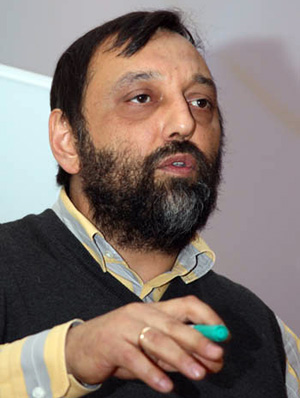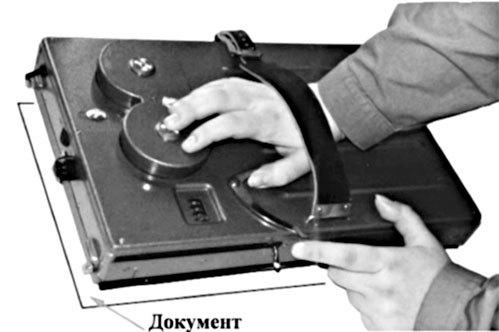Scanners in the USSR - how it all began

With the advent of the new year, users of social networks have unearthed an old filmstrip in their storerooms (a kind of slide show with captions) “In 2017”. Its authors in an intelligible form tried to tell the Soviet kids what the world would be after 57 years on the anniversary of the Great October Revolution: robots, video communication, space travel, nuclear trains.
I was interested in the history of the use and application of the scanner in the USSR.
→ Image Scanner
→ Input / output devices.
→ How the scanner works and works.
')
Images from the 1957 animated film:


However, the future came much earlier, well, with regards to scanners for sure.
The beginning of the spread of computer technology in the USSR opened up a new field for innovative developments.
In the late 1980s, a group of young engineers from the Institute of Automation and Electrometry of the SB RAS initiated the creation of a projection scanner. Having achieved some success, colleagues organized a cooperative and started creating and promoting their development.
The result of their work was a projection scanner Uniscan, which combines the capabilities of a scanner and a modern digital camera. It had a resolution of 72 megapixels. This resolution made it possible to see the individual eyelashes on the image of a person in A0 format.

Tripod scanner
The first scanner samples allowed us to obtain black and white images or images in grayscale. "Open the world in all its amazing dullness!" - joked in the brochures. Exquisite design, these models are also no different.
Later light filters were added to the design, and from that point on the scanner allowed to receive full-color images.
The Uniscan scanner was used for receiving and processing images in the printing industry, for text recognition and database creation, in cartography and design, for creating digital copies of rare books in state libraries, for macro and micro photography of fixed objects. The combination of a scanner with a microscope turned out to be a very demanded forensic medical examination - the Uniscan scanner turned out to be the best that was offered in the world for these tasks.

Microscope with Uniscan scanner
As far as I figured out, this initiative group of young engineers in 1995 (already in the Russian Federation) founded Uniskan LLC, Novosibirsk.

This company is one of the oldest innovative firms in Novosibirsk.

The founder of this company is Akademgorodok Novosibirsk LLC "Uniskan" Andrei Bryzgalov
LLC "Uniskan" and now works quite fruitfully.
All regional forensic examinations are equipped with scanners of their latest modification. The mobile X-ray unit manufactured by Uniskan is certified by the Ministry of Health of the Russian Federation. At its base, the company has developed a mobile digital fluorography complex. In 2006, Uniskan LLC developed a technology for the rapid manufacture of small batches of plastic parts. In 2007, by order of one of the leading enterprises in Russia, a gas leak detection meter, Gazskan-M, was developed. From the closed projects of LLC Uniskan, a joint development with the former defense plant NPO Sever, the underground security system Azimuth, which was acquired by various federal services for the equipment of objects and the protection of state borders.
Scanners for entering slides made it possible to qualitatively enter information from transparent media. This is usually either flatbed scanners with a special slide module, or drum scanners. Their main use is publishing and cartography. By the way, until recently, the teletype, using the principle of a drum scanner, was used to transmit page layouts of central publications throughout the territory of the former USSR.

Of course we were not the first in this area.

The first SEAC drum scanner *, Russell Kirsch and the background scanner control panel. 1957, United States.
But not outsiders.
Soon in the USSR appeared "hand" scanners.

From the domestic coding devices with freely movable sight, PKGIO is known - “Semiautomatic Coding of Graphic Information Optical” (the optical part is apparently a viewer in the form of a magnifying glass with a crosshair and an embedded induction coil).
The kit also includes an electric pencil and keyboards: a double (Russian and Latin, as well as an additional one with Greek letters) a push-button keyboard and a keyboard in the form of a table with holes, into which you have to stick an electric pencil - it is mounted on the tablet next to its working field. The resolution of the device reaches 0.1 mm.
I would like to mark a special category of scanning (or rather, copying) spyware equipment.

The most well-known special means are photocopiers “Cinnamon”, “Winter” and “Tan”

Cinnamon photocopier (from Keith Melton Spy Museum archive)
The effectiveness of the use of rolling machines, as well as the need for fast and high-quality copying of a large number of documents, prompted the developers of NIL-11 (a specialized laboratory that was part of the Operational Technical Department (KTR) of the KGB of the USSR ) to create a portable photocopier for A4 documents. In the new camera called “Cinnamon,” the document was covered with a pressure glass of the working side of the device (with dimensions like the A4 format), and the mirror-prism mechanism moving inside the device was evenly scanned over the document under the action of a spring.
For uniform illumination of the document, a special thin and long illuminator, like fluorescent lamps, was used in the Koritsa, which moved with a mirror-prism mechanism. Its movement, as well as the transportation of photographic film, was provided by a spring cocked by a side lever for shooting a single frame. The Cinnamon cassette held up to 400 frames of standard 35 mm film and could quickly be replaced with “fresh” in the light in a few seconds, which made it possible to copy a large number of documents. The aperture of the lens was selected depending on the sensitivity of the film. Cinnamon had a frame counter as well as a convenient shutter lever that worked from both the right and left hand. A standard 110/220 volt power supply could be used to power the Cinnamon illuminator, as well as a 12 volt voltage through the vehicle's cigarette lighter socket.

Set of apparatus "Cinnamon" (from the archive Keith Melton Spy Museum)
Cinnamon turned out to be a very effective device for quickly copying a large number of documents, for example, when the officer-curator received secret documents from his agent for a fairly short time, copied them in the car, observing the conspiracy requirements, and after completing the work, returned them to the agent in advance agreed by. “Cinnamon” was also actively used in safe houses and in rooms of hotels, where the documents received for the period of time were delivered and returned to official storage after photocopying. The dimensions and weight of the “Cinnamon” together with the power supply unit and pre-equipped photo cassettes made it possible to transfer the entire set in a regular briefcase or attache case, which ensured the conspiracy of the whole activity of working with the device both in a car parked or in motion, and for document shooting in room.
Operational units of the KGB actively used “Koritsa”, noting the simple setup and convenient control of the device, in connection with which the serial production of “Cinnamon” was organized at the Krasnogorsk plant, where the device was assigned the factory index C-125.
Later, the KGB prototype, developed for using 16 mm film with an electric motor to drive a mirror-prism system and a film transport mechanism, entered the operational divisions of the KGB. The new device "Winter" was smaller in size and provided copying of A4 document in two times with overlapping each half of the sheet. The "Winter" cassette was designed for 400 frames, it contained 6 meters 16 mm of film with double perforation and sensitivity from 45 to 700 units. GOST. Photographing one frame began after the lever-switch shifted to the right with the thumb of the right hand and was carried out for 2.5 seconds. The power supply units included in the “Winter” package ensured that the device operated from a 12-volt automobile network and from a standard 110/220-volt power supply network.
Despite the smaller dimensions and the presence of an electric drive, the Zima device did not receive active use in operational practice. According to KGB officers, the apparatus often lay for years in the storage areas of operational equipment and was removed only for annual inventory. According to experts, copying the A4 document for two times proved inconvenient, and many operatives preferred the old “Cinnamon”.

Photocopier "Winter" (from the archive Keith Melton Spy Museum)
In the mid-1980s. a prototype of “Cinnamon” and “Winter” appears, the camera “Tan”, for copying a full A4 sheet onto a 16 mm film with electric drive of the mirror-prism scanning and transporting film mechanism.
The “Zagara” cassette was designed for 400 shots, the kit also included two more tapes. Thus, "Tan" could provide a relatively fast copying of more than a thousand sheets of documents.

Photocopier "Tan" (from the archive Keith Melton Spy Museum)
However, the new “Tan” did not receive active use, possibly due to the relatively large weight (over 3 kg) and increased dimensions, which most likely turned out to be inconvenient for operational officers in the case of transportation of “Tan”, which was already difficult to place in standard portfolio. In the second half of the 1980s. began the active use of computer scanners, on which copying was much easier compared to the cumbersome “Tan”. All this led to the fact that the factory party "Zagarov" has not found application. New sets of this device were stored for a long time in the warehouses of operational equipment until it was instructed to send the entire batch to NIL-11 for destruction or possible use of individual units, components and parts.
So ended a century of highly effective use by the KGB units of rolling cameras, which gave a lot of necessary and especially important for the USSR documents, including copies of materials in rare languages, when the requirements of high definition of the negatives were particularly high. Today, in the arsenal of modern intelligence, there are various household digital devices that allow, without any camouflage, it is quite open and easy to scan documents and drawings of any complexity.
Today, without scanners, we can no longer imagine our normal life:

3D virtual simulation of ships for the Russian Navy - are we on the crest of IT?
That's all that I managed to dig about scanners in the USSR.
Maybe someone knows more?
Used documents, photos and videos
www.uniscan.biz
www.zxpress.ru/book_articles.php?id=2389
www.antona1976.livejournal.com/175729.html
www.wikipedia.org
www.photohistory.ru
www.compuart.ru
www.ya-russ.ru
www.ribalych.ru
www.pulson.ru
www.rutlib.com
www.uniscan-research.ru
www.strf.ru/material.aspx?CatalogId=223&d_no=28744#.WKCRbvmLRaQ
www.zavtra.ru/blogs/sssr_2017
www.zxpress.ru/book_articles.php?id=2389
www.antona1976.livejournal.com/175729.html
www.wikipedia.org
www.photohistory.ru
www.compuart.ru
www.ya-russ.ru
www.ribalych.ru
www.pulson.ru
www.rutlib.com
www.uniscan-research.ru
www.strf.ru/material.aspx?CatalogId=223&d_no=28744#.WKCRbvmLRaQ
www.zavtra.ru/blogs/sssr_2017
Sources
Spy Arsenal. The history of operational technology intelligence / Authors: Vladimir Alekseenko, Keith Melton
Source: https://habr.com/ru/post/401453/
All Articles